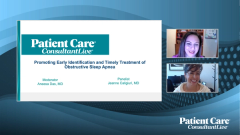
Opinion|Videos|January 13, 2025
Identifying Patients With OSA
Author(s)Aneesa Das, MD , Jeanne Caligiuri, MD
Panelists discuss how health care providers can identify patients at risk for obstructive sleep apnea through screening tools, clinical history assessment, and recognition of key symptoms such as daytime sleepiness, loud snoring, and witnessed breathing pauses during sleep.
Advertisement
Episodes in this series

Newsletter
Enhance your clinical practice with the Patient Care newsletter, offering the latest evidence-based guidelines, diagnostic insights, and treatment strategies for primary care physicians.
Advertisement
Latest CME
Advertisement
Advertisement
Trending on Patient Care Online
1
Adult Stimulant Use Accounts for Most Recent Growth in ADHD Prescribing in Canada
2
Retatrutide Achieves Up to 28.7% Weight Loss and Marked Knee Pain Reduction in Phase 3 TRIUMPH-4 Trial
3
10 Questions on The Holiday Spirit
4
ADA Publishes 2026 Standards of Care With Updates to Sections on Technology, Obesity, Cardiometabolic Disease Management
5
















































































































































































































































































